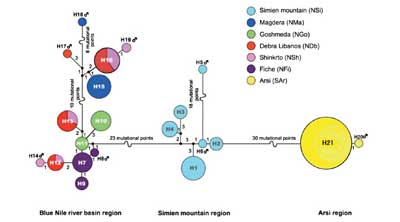



|
TOPICS BONOBO Chimpanzee "Ai" Crania photos Itani Jun'ichiro archives Open datasets for behavioral analysis Guidelines for Care and Use of Nonhuman Primates(pdf) Study material catalogue/database Guideline for field research of non-human primates 2019(pdf) Primate Genome DB 
Primate Research Institute, Kyoto University Copyright (c) |
Japanese Genetic diversity within and among gelada (Theropithecus gelada) populations based on mitochondrial DNA analysis
Takayoshi Shotake, Weerachai Saijuntha, Takeshi Agatsuma and Yoshi Kawamoto
Abstract
We studied genetic characteristics within and among gelada (Theropithecus gelada) popula- tions inhabiting the southern and northern plateaus of Ethiopia. Twenty-one mtDNA haplotypes were identified. Geladas on the southern plateau were genetically separated from those on the northern plateau, with a large differentiation as indicated by Fst values of 0.665-0.917. The difference between the subspecies (T. g. gelada and T. g. obscurus) on the northern plateau highlighted a substantial genetic variation. Divergence times were estimated as ~250000 years between subspecies on the northern plateau and ~400000 years between those on the northern and southern plateaus. The genetic differentiation between the geographically distant Simien Mountain and Arsi groups (640 km) was ~2/3 of that between the geographically closer Debra Libanos and Arsi groups (250 km). The difference between subspecies within the northern plateau was similar to that between Papio hamadryas hamadryas and P. h. anubis. The difference between geladas in the north and south was similar to inter-subspecies differences in other mammals, and thus suggested that the Arsi geladas belong to subspecies T. g. arsi (tentative name). Considering the present distribution, geladas appear to have a complicated history of speciation. However, further analyses based on genetics, morphology and ecology are required to confirm these findings.  Minimum spanning haplotype network constructed using Network 4.6.1.0 based on the median-joining algorithm. The symbol ♂ indicates adult or young males. The sizes of circles are proportional to the numbers of haplotypes.
Bibliographic information
Anthropological Science Published online 29 September 2016 in J-STAGE (www.jstage.jst.go.jp) DOI: 10.1537/ase.160717 or https://www.jstage.jst.go.jp/article/ase/advpub/0/advpub_160717/_pdf хр? 2016/10/05 Primate Research Institute
|